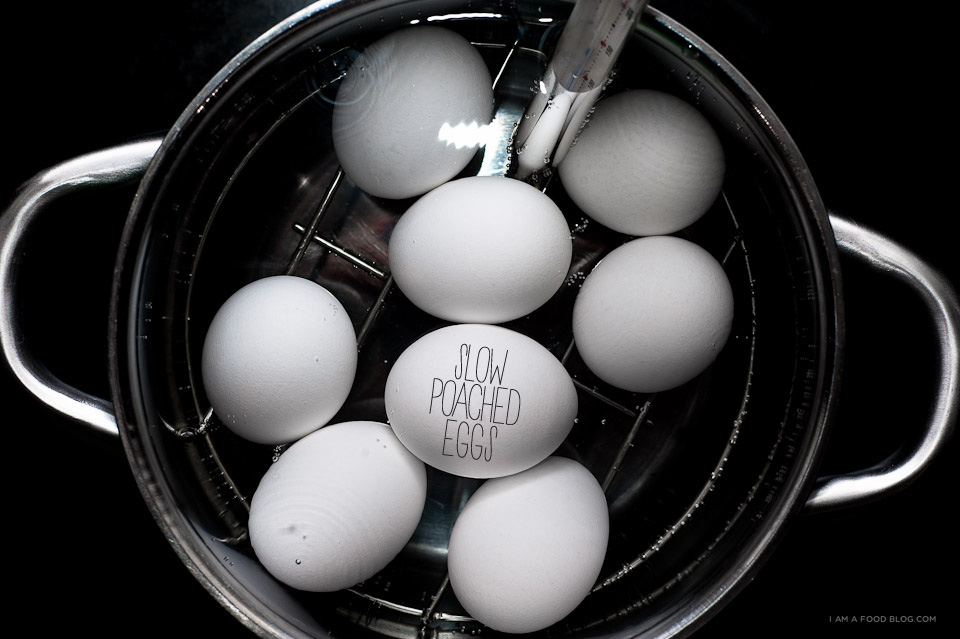
I love eggs. They’re super versatile and a great way to add extra protein (and oomph!) to a dish. As a breakfast lover, I pretty much enjoy all styles of eggs, but poached hold a special place in my heart. See, I’ve never made a poached egg…at least not the traditional way.
Poached eggs done well are soft, creamy, and ooze perfectly over toast or crispy potatoes. Badly poached eggs on the other hand are all over-done whites and hard yolks. Because I’m so particular about my poached eggs and because I’ve had my share of over-done eggs, I’ve convinced myself that poached eggs are the most difficult egg cooking technique. The holy grail of eggs, if you will.
In my search for the easiest poached egg recipe I saw multiple egg poaching methods: water-swirling, vinegar-ing, plastic wrapping, and silicone podding. All the methods seemed too persnickety to try, so I went with the simplest method possible.
Turns out that the simplest way to poach eggs is to slow poach them. I found the technique in New York chef David Chang’s cookbook, Momofuku. Chang’s slow poached eggs are based on onsen eggs, a Japanese egg cooking technique. Eggs are slowly cooked in their shell in 145 F hot water for 45 minutes. Because the eggs are cooked so slowly, the eggs are super creamy: the whites are just set and the yolks gloriously oozy.
The beauty of slow-poached eggs is that they are cooked in their shell. Because they’re already naturally packaged, you can make a bunch at a time and have them in the fridge on hand anytime you have a poached egg craving. You can use these eggs anywhere you’d use regular poached eggs. If you’re having people over for brunch, it’s awesome because you can prep all of your eggs the night before and just heat them up in a bowl of hot water. Crack them open and watch your friend’s faces light up in amazement when your “raw” eggs slide out of the shell perfectly poached.
I am oozy, I am unctuous: I AM SLOW POACHED EGG!
Slow Poached Egg Recipe slightly adapted from Momofuku
- large eggs, as many as you like
Place a steamer rack in your biggest pot and then fill the pot with the hottest tap water possible. Put the pot on the stove on the lowest heat.
Clip a thermometer to the side of the pot and monitor the temperature. You want the water between 140-145 F. When the water is the right temperature, add the eggs to the pot and let them hang out for 40-45 minutes checking the temperature regularly. Add a couple of ice cubes if the water gets too hot.
The eggs can be enjoyed immediately or you can keep them in the fridge for a few days. If you want to keep them in the fridge, chill them in an ice water bath before storing in the fridge. To warm up, place in a bowl of piping hot tap water for a couple of minutes.
To eat, simply crack open the egg into a small saucer. There may be a tiny bit of white that is a bit loose, tip the dish to pour it out then slide the egg on the dish you’re using it in. Enjoy!
**Fried Slow Poached Eggs
If you’ve made a big bunch of slow poached eggs and you’re wondering what to do with them (as if!), try pan frying them in a bit of oil over medium high heat. You’ll end up with perfectly runny yolks, creamy whites and crispy brown sides.
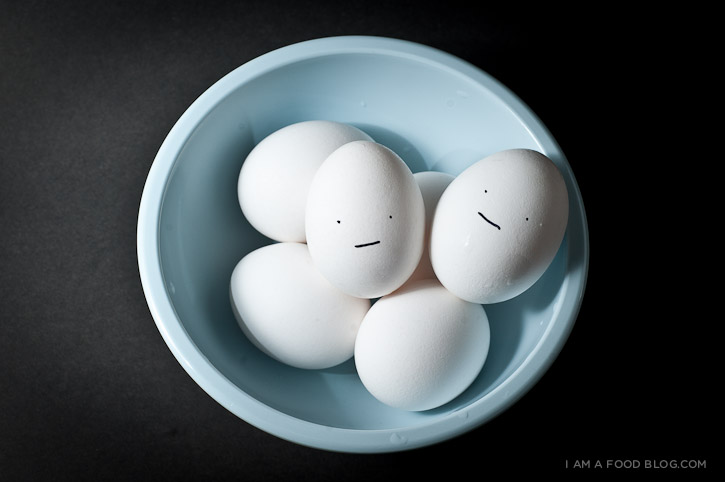
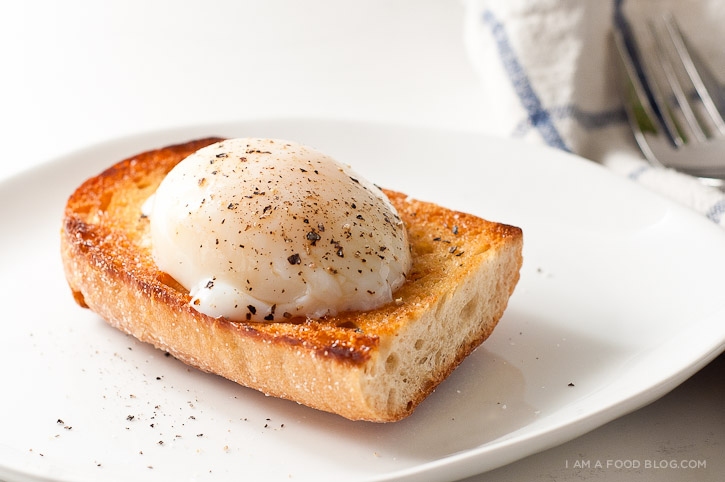


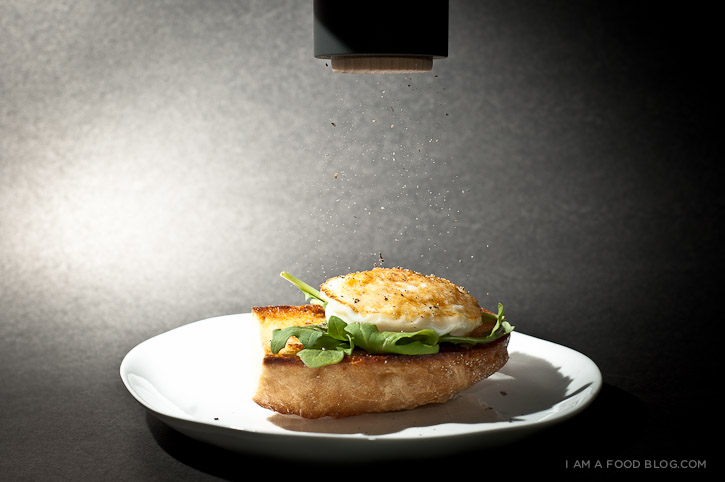
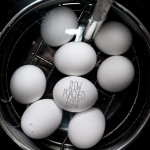
Nice! I had no idea you could do this…
You got me at easiest…Your pictures are amazing!
I’m not sure how these are different from onsen tamago?
dont think they are different… its essentially the same thing … but if i remember correctly it takes 15~ 20minutes back home for the onsen tamago ….
Bah!
oh my god. this is perhaps perfect. and a fried poached egg, wow.
This method of poaching eggs seemed so foreign to me – I had to try it! I had a pot of water heated to exactly 145ºF, a timer set for 45min, and watched them the entire time. I cracked open an egg into a ramekin – holding my breath the whole time – and out plopped a frothy mixture of cooked and uncooked whites with a hard, solid yolk.
I’m completely baffled! How did the yolk cook faster than the whites? How did this technique not work for me? Help!
Hi Quanny,
I did some research and it turns out that egg whites start to thicken around 145 F and egg yolks set at 149F. If your temperature was closer to 149F (could be a slightly off thermometer), then it’s completely plausible that your yolk was set and your whites raw. Check out this helpful site for more info: http://north19.co.uk/sous-vide-poached-egg/
That makes zero sense mate. So the whites start cooking at a lower temperature than the yolk. Therefore the water being 149f cooks the yolk faster than the white??? How so? I
The whites START cooking at 145F.
So at 145F they start – and continue, to cook.
If the temp rises to 149, It makes the yolks solidify, or set. (- not cook, SET.)
Maintaining a temp of say, 146 will continue to cook the whites without reaching the temp at which the yolks will solidify, or set.
Maybe you had a really stale egg? It looks like the loose white of the egg sets at a higher temperature than the yolk while the tight white sets at a lower temperature than the yolk. http://mobile.seriouseats.com/2013/10/sous-vide-101-all-about-eggs.html
Just a guess ;)
It turns out the proteins “denature” (coagulate in layman’s terms) at different temperature. If you cook the egg for long enough (at a degree or two lower) that the whole thing reached the same temperature, the yolk would be completely hard and the white completely runny. Yolk coagulates at a lower temperature than white.
When you boil an egg, the white (on the outside) reaches a high temperature quickly and coagulates; the yolk is insulated and doesn’t reach a high enough temp to coagulate before you fish it out.
That’s exactly what happened when I tried to poach with this method. The whites were runny and the yolks were solid. I’ll try it again. Thanks for the advice!
I had EXACTLY the same result.
It seems that in addition to the yolk, eggs actually have two “whites”, the “tight white” (closest to the yolk) and the “loose white”, and each of theses elements congeal at slightly different temperatures. That explains the results I got.
I’ve seen information that the “tight white” hardens at the lowest temperature, the yolk second, and the “loose white” at the highest temperature. Although in my own slow-cooking experiments the yolk seems to solidify at the lowest temperature.
The whole point of sous-vide cooking is to cook your food to the same (highly controlled) temperature all the way through. Given that most of us prefer solid whites and runny yolks, I really don’t see the point of slow poaching an egg. We WANT the yolk cooked less. Nor do I see how these professional chefs manage to make the perfect slow-cooked poached eggs they do, unless their water bath is at least the temperature necessary to gel the “loose whites”, and they pull them out before the egg is heated all the way through to the yolk.
Not one to waste a perfectly delicious egg, I popped my “soupy” slow-poached result in the microwave at half-power and cooked it for about 20-30 seconds until the loose whites congealed and ate it. Of course the yolk was hard, but I have to admit the whites did have a nice, light fluffy texture.
Another trick I have seen is to slow cook an egg, and then pop it into boiling water for 30s to firm up the white.
onsen tamago! I love Japanese slow poached eggs – thanks for demystifying it!!!
I have never seen this method, ever. It is so cool!! Problem is I don’t have a thermometer… but it’s on “the list”, so I am excited to try this. The other poaching methods have never quite worked.
Gorgeous pics, too!
I’ve been obsessed with onsen eggs after a recent trip to Japan and after a bit of trial and error and lots of internets-ing I’ve managed to get it down to this EVEN EASIER than David Chang’s routine (ie NO THERMOMETER! hurrah!):
– bring a pot of water to the boil (enough so the egg will be completely covered)
– turn off the stove
– chuck an egg in and cover for 12-15 minutes
Now, all the internet tells me to bring the egg up to room temperature either by leaving it out for a bit or putting it in a bowl of standard tap water. I have never done this and put the egg straight into the pot from the fridge and leave it in for 13 minutes (15? everytime I’ve done 15 it’s turned out like a soft-boiled egg :( ).
I have no idea about eggs and salmonella in different countries (apparently in Japan the date of picking is stamped on the eggs so you are always sure of their freshness) but I’ve been eating eggs like this for over a year and haven’t gotten sick. Be warned, I have read that this method does not heat the egg up enough to health and safety standards so I guess that’s why professionals have to use thermometers to be sure …
Can you please explain what the steamer rack is for? It looks like you submerge the eggs in the water. Is the steamer rack just for ease of removing all the eggs at once?
The steamer rack is to keep the eggs off the bottom of the pan. The water at the bottom of the pot is slightly hotter than the middle.
Could you cook them in a pot of water in an oven that is 145 degrees?
I haven’t tried just because my oven doesn’t go this low. Let me know if it works out for you if you do try it!
I was impatient to try this and didn’t have a thermometer, so I tried Jo’s method above, waited the 13 minutes, and…almost-hard boiled egg. :( I am determined to get it right though, so I will try again! Thanks for the idea.
Hope it works! Eggs are so fiddly and dependent on size, ur fridge temp etc etc. I just kept lowering the time by 30 secs until it worked for me so here’s hoping it eventually works for you!
Jo…did you leave the pan on the stove top?
oh WOW – I’ve never mastered poached eggs and now I don’t think I’m going to have to! Thanks! :)
This look perfect!!!I’m gonna try it!
Well, my first attempt was overly cautious (I guess the temperature too high [of course I didn’t check thermometer or use ice cubes], and let it in too long), but I’m on my way to perfecting it – thanks to YOU ;-)
hi just need to advise people that eggs should be brought to room tepmreture and the eggs must be freshest possible. luckily i have chickens on our property and as people know theres nothing fresh like home grown.
Wow, this is so cool. I’ve been making this for years, but it only takes 3-6 minutes! Oh, and it’s called a soft boiled egg. It’s not innovative to take a short process(either soft boiling or actual poaching) and turn it into a 45 minute ordeal….
Snarky!
And ignorant at the same time. Go find your own internet.
My foolproof method I learned from Sandy Gluck from Martha Stewart Radio: bring a pot of water to a boil. Carefully add you egg(s) to the water. Set at timer for 5 minutes and continue boiling. Remove eggs from water after 5 minutes. I usually let them sit for 30 secnods or so while I get my toast ready in the bowl. I crack the shells, scoop out the inside and perfect eggs every time! Runny yolk, firm white!
this is perfect!
thanks! nomnomnom…
You just changed my life.
Oh man! Just discovered your blog after hunting for Ikea meatballs.
The poached egg recipe is something I’ve wanted to try after reading that cookbook.
Eggs to me are the best food ever and soft poach is the best.
Thanks for this blog very much appreciated.
I’ve tried to find the same steamer rack in your photo for Slow Poached Egg AND Steamed Fish for my wok at home. Nothing else will do. I am OCD too. Please can you tell me what you bought as your steamer rack? Many Thanks-!
Firstly, the pictures are amazing. Secondly, this really looks so delicious! I love pouched eggs so this is just a perfect recipe for me! This can be a perfect snack anytime of the day! Thank you for sharing this post. I am so excited to try this out!
I use the swirl and vinegar method to poach my eggs, definitely the most fool proof IMO. But the idea that I can pre-cook a bunch and refrigerate for later use is incredible to me! Quick eggs benny here I come!
recently attended a gathering of over a hundred people, and for breakfast one orning we had egg benedicts – with these magic eggs – a great trick to fast serve a crowd, hi five to the cooks.
Cooked tons out of that book – thanks for the photos and remind.
Note to self – buy eggs tomorrow and cook tomorrow night for overnight guests on Sat!
I’m trying this “onsen” method at the moment using a collapsible steamer basket. Luckilly, I have a thermometer and a gas stove so I can keep it on the low after the water reaches 145F. I’ve added only 2 ice cubes so far after 35 minutes to bring water temp down to 145. This is an absolutely easy, no fuss, fool-proof method for poaching. Yes, I brought the eggs to room temp first before putting them in the pot. Thanks for posting this!
one of the best blogs I’ve ever seen. WOW
I use an electric pot. It holds the set temperature and I use a digital thermometer to beep if for some reason, it gets too hot. (Which it shouldn’t and doesn’t.)
I find this method intriguing. But I’ll try it only if I can be sure of maintaining a constant low temperature of the water. I may have to do some shopping for equipment. In the meantime, I should share my no-fuss method:
1. Break eggs in a small coffee cup.
2. Bring water to a boil in a medium sauce pan.
3. Pour in the eggs — not carefully. Just dump them into the boiling water. You don’t have to swirl the water or add vinegar.
4. Maintain the heat, until the eggs return to a boil. For me, about 30 seconds on a gas stove. Keep an eye on it to avoid boiling over.
5. Turn the heat off. Wait four minutes (for soft, liquid-y egg yolks).
6. Prepare a bowl for the eggs merely by placing a half-paper towel on the bottom.
7. Pour one or two eggs in a strainer with large holes. Drain it a bit.
8. Place the eggs into the bowl. Remove the wet paper towel.
9. Eat.
<3 thanks for the awesome post! I've always wondered what onsen eggs would be like (I only knew of them from anime and playing Harvest Moon *blush*) and I'd been looking for a good egg poaching recipe. It's kinda neat that something I've only known about in passing is actually the best way to poach an egg!
Another tric is to use a domestic bench fryer with a dial-set temperature. Clwan the bowl before adding the water and experiment with the temperature setting (I’ve never found one that is 100% accurate) then use a white-out pen to put a small dot on the exact temperature mark on the dial. You still need a cake cooling rack of some kind to keep the eggs off the bottom, (which is usually in direct contact with the heating element underneath) and it’s still desireable to have the eggs at room temperature before adding them to the water.
But because the pan is thermostat controlled, it takes some of the effort out of maintaining the temp with ice cubes etc. for the whole 45 minutes.
Another method you can try is to bring the water to the boil, then lower in an egg at room temperature, immeadiately place on lid and REMOVE from the heat source for EXACTLY 4 minutes.
this only works for one egg of 65-70gms (and fairly close to sea level.
Though it works for me, I haven’t experimented with high & Low air temperatures or different altitudes, which change the temperature at which water boils.
Sounds like a lot of time and effort for an egg. They must really be wonderful, because I can’t imagine waiting 45 minutes for breakfast! My no-fail poached egg method is very simple: Bring water to boil, crack egg in it, time for 3 minutes. Perfect every time.
I just tried this and this method is definitely the best. The egg stays clean and together rather than running into a big splattered mess which doesn’t fit correctly on the toast. I will always use this method. =)
Holy shit– this was delicious and easy. Toast with porcini pate on top
I’ve been making poached eggs since I was 13 years old. I would make them for friends who stayed overnight:-) I have never,ever had one not turn out!! I just let water in a pot start boiling ” a nice low-medium,more low” , then I crack the eggs right into the water “2-3 at a time”. I wait just until the whites have cooked up and then I remove them with a slotted spoon onto my toast. Works every time and us super yummy!!!
If the water is at a good boil when you add the eggs the whites will tighten faster and not run all over. They may not be perfect looking but there not all over the place . They fit right in the middle of a piece of toast:-)
Why, why, why have I not thought of this? I totally have David Chang’s cookbook. I totally remember reading his slow-poaching method but not identifying it with poaching because it’s done in the shell. Thank you for reminding me about this. I am absolutely HORRIBLE at poaching eggs, but I think you have inspired me to give it one more go. Also, congratulations on the winning Saveur’s Editor’s Choice Best Food Blog Award!
Heidi
Thanks Heidi! I love the Momofuku cookbook…especially the asparagus with miso butter! :)
This looks to be my perfect first use of my new sous-vide circulator….
very interesting, but i’m not taking 45 minutes to make an egg, man. this method is probably great for cooking batches of them for large groups though.
MIND BLOWN!!!!!!!
Okay, this might be a life-changing post. Such a genius, GENIUS, technique to cook poached eggs.
Interesting method but I can’t wait 45 minutes for a poached egg when there’s a much quicker and very easy way. Just put a piece of cling film (aka saran wrap)into a small cup or ramekin. Lightly oil, crack on egg into it and then pull up the sides of the cling film and twist. Place into slightly simmering water (I hang the twisted part on the side of the pan so it’s easier to retrieve) and cook for 5 minutes. Scoop out onto kitchen towel, then open carefully and put onto toast. Works a treat.
Also, I’d worry about salmonella if I was storing partially cooked eggs. You should check that out.
Looks awesomesauce but 45 mins? Hmm. I usually don’t have the patience to go 5 mins when I have the hankering for a poached egg (especially when I’ve snoozed the alarm about 8 times and am late for work!)
My favourite, pretty foolproof too, is the microwave method.
Not a purist. Just a foodie.
https://www.youtube.com/watch?v=VMWuzNlrlUw
If you need to keep the eggs off the bottom and don’t have a rack that is the exact size of your pot, use a collapsible metal steamer and just put a little more water in the pan so that the eggs stay covered.
I have poached eggs on a number of occasions, never knew you could do it this way awesomeness!!
Thank you so much for posting this. I was intrued. Tried it today with 6 eggs straight from the fridge in a bamboo steamer insert submerged in water when it reached 145F. Temperature of the water fluctuated from 137-148 (via IR gun) throughout cooking. I was a little concerned the yolks were cooked through but did not. Our guests loved it!!
I really hate runny whites, and love soft runny yolks. Closest I come is soft boiled or 11/12 minute eggs started with cold water. I put eggs in a saucepan add cold water and put on stove to boil. Once the water is boiling I turn it down to a simmer until the 11/12 min are up then run cold water on the eggs immediately. My yolks are soft and there are no runny whites at all. This also makes them easier to peel. This recipe sounds similar. So what is the difference between soft boiled and poached in shell? Seems like more work to me since you have to keep watching the temperature…. of course I think the shape is also different as poached eggs are not usually egg shell shaped like boiled eggs are. They slide around on plates because of the water they are cooked in. The pan I have uses steam to cook them (inset has 6 little round metal dishes with handles for ease of removing) and they usually turn out well. I just wondered if there was a quicker, easier way, but I guess not. Thanks for the info.
Watery mouth.
Great method, both yolk and white cooked to perfection.
You might like to reheat the eggs in hit 35 %fat cream that you have heated on high heat until it has reduced by half and into which you will have put a half tea spoon of tarragon and coarse ground black pepper! Slip in the eggs out of the shell for about 3 minutes off the heat, don’t cook them!!
Sorry if already answered, but it says fill the pot, but use a steamer, so I assume only fill the pot up to the level of the steamer- not all the way? Also, should I put a lid on or no after the eggs are in?
hi k,
the eggs are completely submerged in the water, the steamer rack is just so that the eggs are not on the bottom of the pot. you don’t need a lid. hope that helps!
Thank you! It’s not very often I see a new method of poaching eggs so I will be giving this one a try. I am a tad skeptical about how you crack the egg and the poachie comes out? Wouldn’t the white be too solid? But I have an open mind, and I am prepared to be amazed. Happy poaching.
I used a single burner induction hot plate with a digital setting for the temperature control. After setting the hot plate to achieve about 140 degrees F I cooked the eggs for 43 minutes. They came out perfect. It was rewarding to crack the egg shells and watch the eggs roll out whole onto a waiting piece of buttered toast.